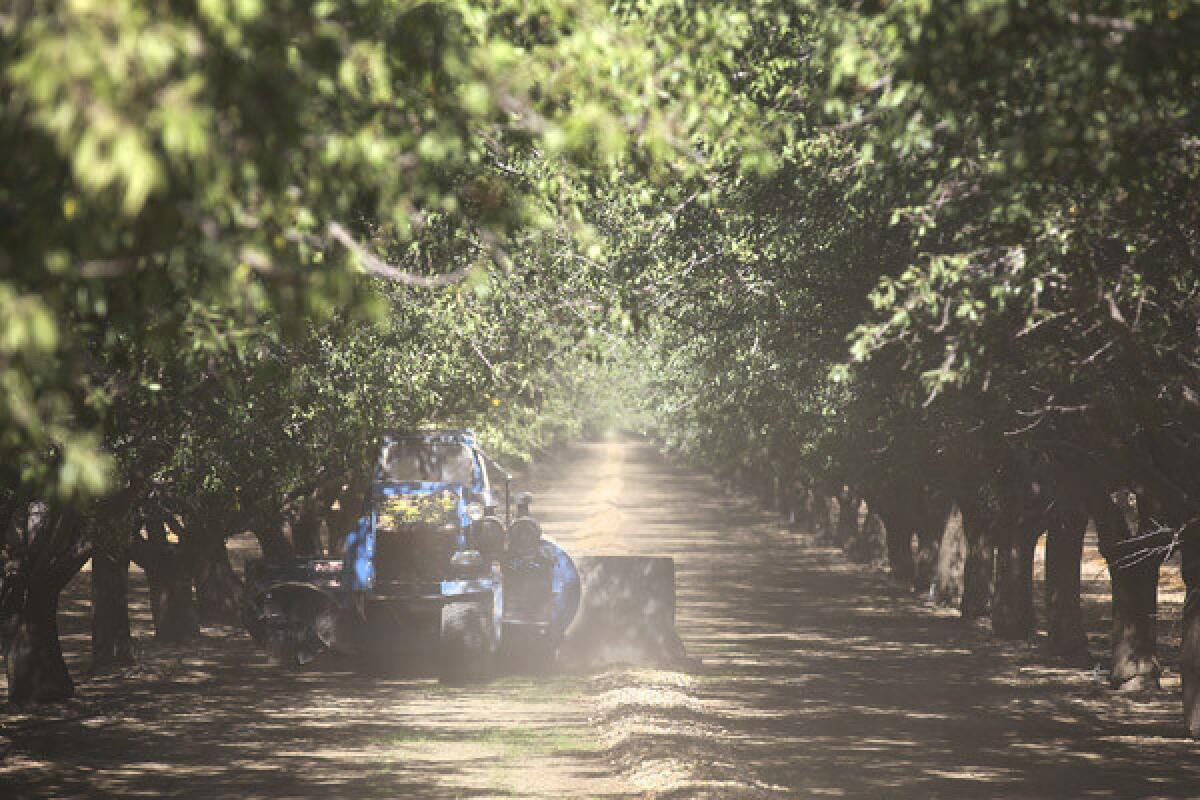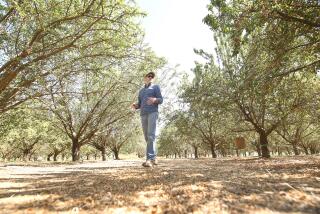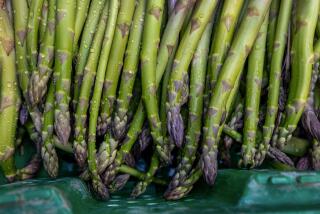Farmers Markets: Almonds at the stands

WASCO, Calif. — California’s almond harvest, which takes place from August through October, is a dusty, noisy affair, vast in scale and fascinating in its blend of agricultural and industrial processes. Sixty years ago California grew 100,000 acres of almonds, 85% of them in the northern Central Valley, from Madera to Butte counties. Mechanization, increased irrigation in the southern San Joaquin Valley (at least until recent water cutbacks) and booming exports have boosted production, and California now raises some 760,000 acres of almonds, its third largest farm commodity, after dairy and grapes. Two of the top three almond counties are Kern and Fresno, where endless vistas of almonds line the highways.
Most vendors at farmers market offer almonds as one of many products; only a few are almond specialists like Fat Uncle Farms, which grows 18 acres of the nuts in Wasco, northeast of Bakersfield. On a roasting morning, the owner, Alan Townsend, explained that the harvest is composed of several parts. These begin when the almonds, which are stone fruits resembling small, elongated peaches, split, turn pale brown and can separate readily from the branch.
First, farmers clean the orchard floors by mowing and sweeping. Then mechanized shakers clamp the trees and shake them vigorously, so that the almonds fall to the ground; the branches rise up as their load is shed.
The fruits are left on the ground to dry. This is necessary because if the moisture in their hulls (the fleshy outer part) is too high, they’re hard to process, and self-heating causes spontaneous combustion and disastrous fires.
Several days to a week after shaking, a small tractor with a rotating boom and a blower sweeps the nuts off the berms into windrows. The next day a harvester collects the nuts and delivers them to a processing facility.
At Kernpareil, a huge, cacophonous factory packed with conveyor belts, rollers and filters, the debris (such as sticks and stones), hulls and shells are removed. The shells are sold for cogeneration and mountains of hulls for cattle feed.
At farmers markets it’s easier than at supermarkets to determine the freshness and variety of almonds, and to obtain unpasteurized nuts.
The leading California almond variety, Nonpareil, has large, attractive kernels but mild flavor. Other varieties, such as Carmel, Butte, Sonora and Fritz, have more intense flavor, like almond extract, and are worth asking for at farmers markets.
“Personally, Fritz and Sonora are the varieties I like best,” said Kevin Philley, general manager of Kernpareil, straining to be heard above the roar of his plant. “But when we pull five-gallon buckets for farmers, they all have their own preferences.”
Fat Uncle, which harvests its almonds early and gets them back quickly from Kernpareil, has already started selling its new crop at farmers markets. Some other vendors are still working on selling the last of their old-crop nuts, which may be perfectly good, but it makes sense to ask what you’re getting.
Almonds keep best in the freezer. They can be stored commercially for several years with good temperature and humidity control, but the newly harvested crop does taste fresher. Like just-shucked corn, almonds taste especially fresh just out of the shell, and sales of in-shell almonds have soared in the last decade.
Commercial growers are required to pasteurize almonds to protect against bacterial contamination, using irradiation, chemicals or heat treatment, which some buyers find unappealing. Steam heating, the organic method, cooks the nuts and alters the flavor, says Nate Siemens, Townsend’s son-in-law. Producers can sell unpasteurized nuts directly to consumers, no more than 100 pounds a day per customer, and these are popular at Fat Uncle’s stands at the Santa Monica Sunday and Wednesday markets and the Mar Vista, Ojai and Santa Barbara farmers markets.
One of the best sources for high-quality unpasteurized almonds is Yemetz Family Orchards, which grows in Livingston, in Merced County, and sells at the Hollywood farmers market. Unlike most vendors, George Yemetz and his wife, Elizabeth, make a point of distinguishing their two varieties, Nonpareil and Carmel, and guiding customers to choose between them, with sample and descriptions. Their new Nonpareil crop will be in later this month and the Carmels by December.
Another source of unpasteurized almonds is Organic Pastures, better known for their unpasteurized raw milk. They also have 80 acres of Butte and Padre almonds in Fresno and sell them in vacuum packs at the Torrance Saturday, Hollywood, Santa Monica Wednesday and South Pasadena markets.
Tip of the week: Weiser Family Farms has started to bring deep orange aji amarillo chiles, which have a medium-hot pungency and full-bodied, fruity flavor. They’re the most common chiles in Peru, where they are used in salsas, ceviches and powders. They have been rare here, but Weiser has 1,600 plants and hopes to offer the chiles for a month or so.
More to Read
Eat your way across L.A.
Get our weekly Tasting Notes newsletter for reviews, news and more.
You may occasionally receive promotional content from the Los Angeles Times.










